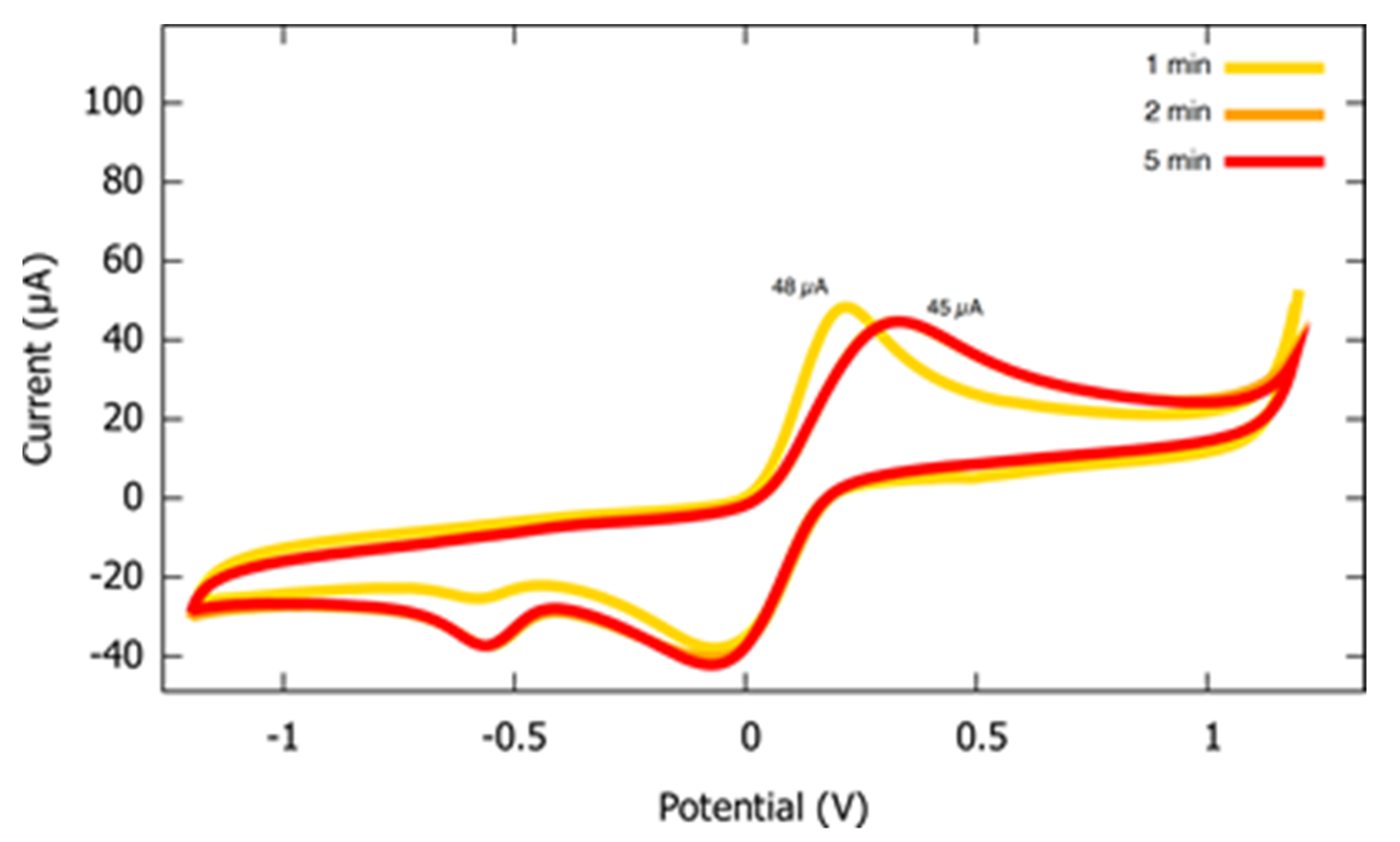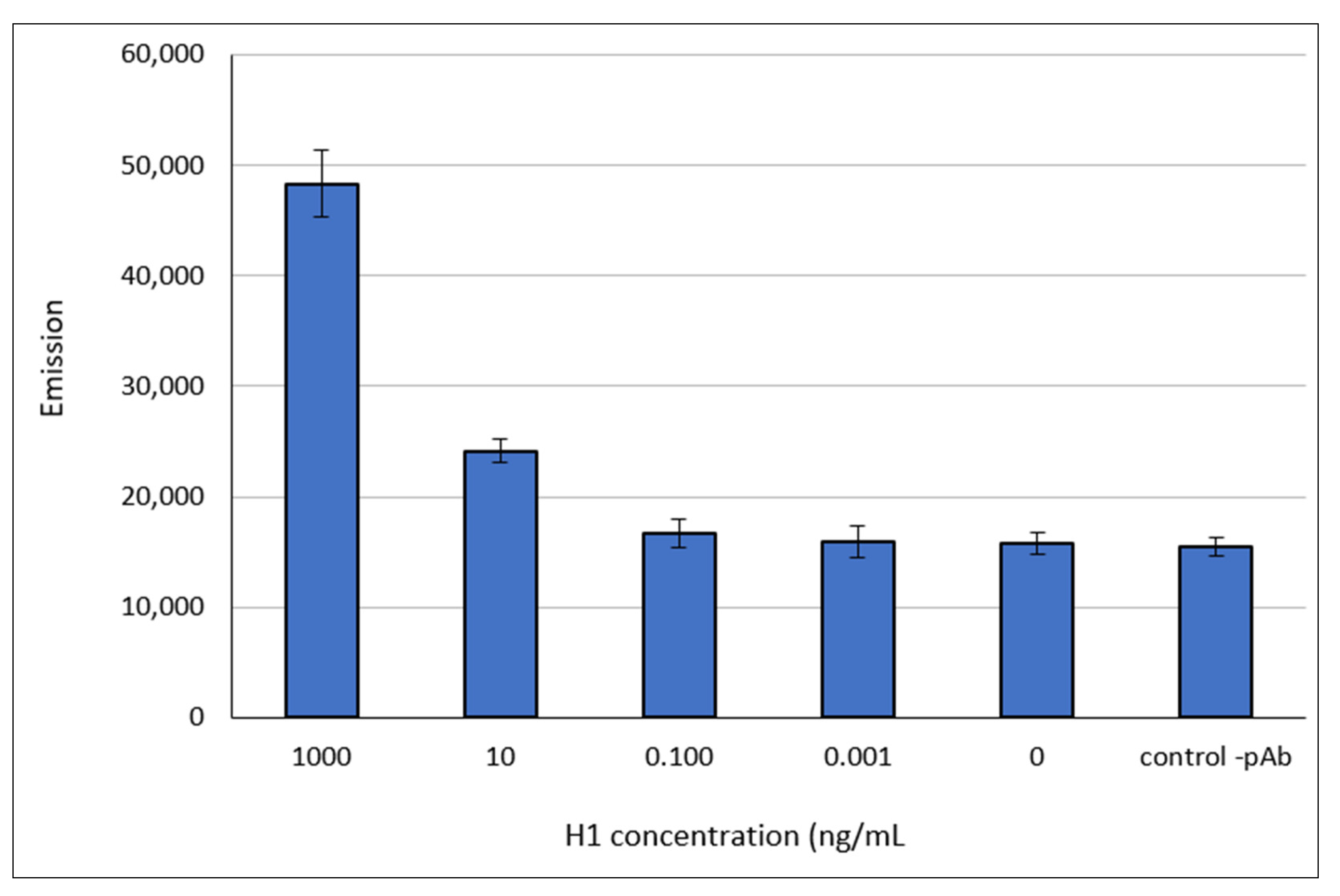Developing an Electrochemical Biosensor for the Detection of Hemagglutinin Protein of Influenza A Virus Subtype H1N1 in Artificial Saliva †
Abstract
:1. Introduction
2. Materials and Methods
2.1. Reagents and Materials
2.2. Electrochemical Measurements
2.3. Electrodeposition of Gold Nanoparticles on CSPE
2.4. Modification of AuNP-CSPE Electrodes with 4-ATP
2.5. Testing of mAb Specificity and Sensitivity
3. Results and Discussion
3.1. Electrodeposition of Gold Nanoparticles
3.2. Electrodeposition Length
3.3. Characterization of NH2-AuNP-CSPE
3.4. Effect of the [Fe(CN)6]3−/4− Concentration
3.5. mAb Characterization
4. Conclusions
Author Contributions
Funding
Institutional Review Board Statement
Informed Consent Statement
Data Availability Statement
Acknowledgments
Conflicts of Interest
References
- Patel, M.; Dennis, A.; Flutter, C.; Khan, Z. Pandemic (H1N1) 2009 influenza. Br. J. Anaesth. 2010, 104, 128–142. [Google Scholar] [CrossRef] [PubMed] [Green Version]
- 2009 H1N1 Pandemic. Centers for Disease Control and Prevention. Available online: https://www.cdc.gov/flu/pandemic-resources/2009-h1n1-pandemic.html (accessed on 11 June 2019).
- Krammer, F.; Smith, G.J.D.; Fouchier, R.A.M.; Peiris, M.; Kedzierska, K.; Doherty, P.C.; Palese, P.; Shaw, M.L.; Treanor, J.; Webster, R.G.; et al. Influenza. Nature Reviews. Dis. Primers 2018, 4, 3. [Google Scholar] [CrossRef] [PubMed]
- Jilani, T.N.; Jamil, R.T.; Siddiqui, A.H. H1N1 Influenza. In StatPearls; StatPearls Publishing: Treasure Island, FL, USA, 2021. [Google Scholar]
- Sriwilaijaroen, N.; Suzuki, Y. Molecular basis of the structure and function of H1 hemagglutinin of influenza virus. Proc. Jpn. Acad. Ser. B 2012, 88, 226–249. [Google Scholar] [CrossRef] [PubMed] [Green Version]
- Ravina, R.; Dalal, A.; Mohan, H.; Prasad, M.; Pundir, C. Detection methods for influenza A H1N1 virus with special reference to biosensors: A review. Biosci. Rep. 2020, 40, BSR20193852. [Google Scholar] [CrossRef] [PubMed] [Green Version]
- Antibodies Use in Biosensors. Available online: News-Medical.Net (accessed on 20 January 2021).
- Sharma, S.; Byrne, H.; O’Kennedy, R.J. Antibodies and antibody-derived analytical biosensors. Essays Biochem. 2016, 60, 9–18. [Google Scholar] [PubMed]
- Chambers, J.P.; Arulanandam, B.P.; Matta, L.L.; Weis, A.; Valdes, J.J. Biosensor recognition elements. Curr. Issues Mol. Biol. 2008, 10, 1–12. [Google Scholar] [PubMed]
- Wang, Y.C.; Cokeliler, D.; Gunasekaran, S. Reduced graphene oxide/carbon nanotube/gold nanopar-ticles nanocomposite functionalized screen-printed electrode for sensitive electrochemical detection of endocrine disruptor bisphenol A. Electroanalysis 2015, 27, 2527–2536. [Google Scholar] [CrossRef]
- Valerio, E.; Abrantes, L.M.; Viana, A.S. 4-Aminothiophenol Self-Assembled Monolayer for the De-velopment of a DNA Biosensor Aiming the Detection of Cylindrospermopsin Producing Cyanobacteria. Electro-Anal. Int. J. Devoted Fundam. Pract. Asp. Electroanal. 2008, 20, 2467–2474. [Google Scholar]
- Rezki, M.; Septiani, N.L.W.; Iqbal, M.; Harimurti, S.; Sambegoro, P.; Adhika, D.R.; Yuliarto, B. Amine-functionalized Cu-MOF Nanospheres towards Label-free Hepatitis B Surface Antigen Electrochemical Immunosensors. J. Mater. Chem. B 2021, 9, 5711–5721. [Google Scholar] [CrossRef] [PubMed]
- Sandwich ELISA Protocol|Sino Biological. (n.d.) Available online: https://www.sinobiological.com/category/sandwich-elisa-protocol (accessed on 13 June 2021).
- Damiati, S.; Haslam, C.; Sopstad, S.; Peacock, M.; Whitley, T.; Davey, P.; Awan, S. Sensitivity Comparison of Macro- and Micro-Electrochemical Biosensors for Human Chorionic Gonadotropin (hCG) Biomarker Detection. IEEE Access 2019, 7, 94048–94058. [Google Scholar] [CrossRef]






Publisher’s Note: MDPI stays neutral with regard to jurisdictional claims in published maps and institutional affiliations. |
© 2021 by the authors. Licensee MDPI, Basel, Switzerland. This article is an open access article distributed under the terms and conditions of the Creative Commons Attribution (CC BY) license (https://creativecommons.org/licenses/by/4.0/).
Share and Cite
Torres-Méndez, C.; Ellamathy, J.; Mascarenhas, M.I.; Liu, Y.; Gkountana, G.-V.; Kühne, P.; Sebastián, J.; Jovanovic, I.; Bern, D.; Nandi, S.; et al. Developing an Electrochemical Biosensor for the Detection of Hemagglutinin Protein of Influenza A Virus Subtype H1N1 in Artificial Saliva. Chem. Proc. 2021, 5, 80. https://doi.org/10.3390/CSAC2021-10477
Torres-Méndez C, Ellamathy J, Mascarenhas MI, Liu Y, Gkountana G-V, Kühne P, Sebastián J, Jovanovic I, Bern D, Nandi S, et al. Developing an Electrochemical Biosensor for the Detection of Hemagglutinin Protein of Influenza A Virus Subtype H1N1 in Artificial Saliva. Chemistry Proceedings. 2021; 5(1):80. https://doi.org/10.3390/CSAC2021-10477
Chicago/Turabian StyleTorres-Méndez, Carlos, Jayendra Ellamathy, Maria Ines Mascarenhas, Yifan Liu, Georgia-Vasiliki Gkountana, Patrizia Kühne, Javier Sebastián, Ivana Jovanovic, David Bern, Sharmilee Nandi, and et al. 2021. "Developing an Electrochemical Biosensor for the Detection of Hemagglutinin Protein of Influenza A Virus Subtype H1N1 in Artificial Saliva" Chemistry Proceedings 5, no. 1: 80. https://doi.org/10.3390/CSAC2021-10477
APA StyleTorres-Méndez, C., Ellamathy, J., Mascarenhas, M. I., Liu, Y., Gkountana, G.-V., Kühne, P., Sebastián, J., Jovanovic, I., Bern, D., Nandi, S., Lüftner, M., Langwallner, V., Lysandrou, M., Taylor, S., Martinovic, K., Atif, A.-R., Manouchehri Doulabi, E., Kamali-Moghaddam, M., & Mestres, G. (2021). Developing an Electrochemical Biosensor for the Detection of Hemagglutinin Protein of Influenza A Virus Subtype H1N1 in Artificial Saliva. Chemistry Proceedings, 5(1), 80. https://doi.org/10.3390/CSAC2021-10477





